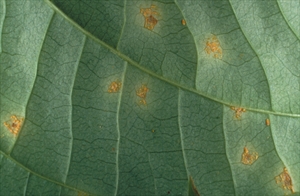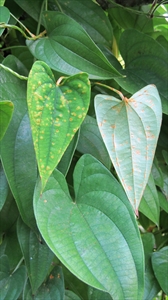Yam rusts
Pacific Pests, Pathogens, Weeds & Pesticides - Online edition
Pacific Pests, Pathogens, Weeds & Pesticides
Yam rusts (097)
Goplana dioscorea and Goplana australis
Goplana dioscoreae is reported from Southeast Asia, Oceania. It is recorded from Samoa and Solomon Islands. Goplana australis has a more limited distribution, and has only been recorded from Samoa and Papua New Guinea.
Yam species, Dioscorea alata (greater yam), and Dioscoea bulbifera (bitter yam or air potato).
Goplana dioscoreae: Yellow spots or pustules (Photo 1) develop on the upper leaf surface (rarely on the lower leaf surface), and sometimes on the petioles and stems.
Goplana australis: Pale yellow pustules, mostly on the under surface of the leaf in groups, 2-4 mm diameter (Photo 2). Pale brown, circular spots with pale green-yellow haloes occur on the upper leaf surface.
Note, the identity of the rust (Photo 3&4) is unknown. It was taken in Papua New Guinea and is provided here to illustrate the general appearance of either of these rusts on the plant. Note the rust on the leaf petioles and veins (Photo 3).
These are minor diseases in most Pacific island countries, and it is unlikely to affect tuber yields. They occur late and the damage is relatively small.
In recent years, severe outbreaks of a rust disease were reported from Pohnpei, Federated States of Micronesia, so it is important to check if symptoms have changed and, perhaps, a more aggressive strain of either of these rusts has developed.
For both species, look for the yellow to light orange pustules on the leaf. Pustules of Goplana dioscoreae are more obvious on the upper surface, and sometimes present on the leaf stalks and stems. Pustules of Goplana australis are mostly on the undersurface.
Symptoms from these rusts are similar and need microscopic examination to identify them.
The disease is usually of only minor importance and apart from biosecurity considerations controls are not normally needed.
BIOSECURITY
In the 2000/2001 yam season in Pohnpei, Federated States of Micronesia, there was a widespread epidemic of yam rust. The rust had been recorded in Pohnpei previously, but was unknown as a serious disease. During the epidemic, more than 80% of the plants were affected in some areas.
It was not entirely clear, however, if the disease referred to as a severe leaf blight, with stem dieback, was due to the rust alone. It was possible that another fungus was present. The description of symptoms and photos resembled those caused by the yam anthracnose, Colletotrichum gloeosporioides (see Fact Sheet no. 16).
Nevertheless, the symptoms of rust were more severe than described previously, either in Pohnpei or elsewhere in the Pacific. The presence of pustules on the stems was particularly noticeable, and unusual. The presence of these pustule caused speculation that a new race might be involved. If true, this has quarantine implications for the movement of planting material between countries.
As the unrestricted movement of plant propagating material has the potential of further spreading yam rust, it should be done with caution, following the FAO/IBPGR Technical Guidelines for the Safe Movement of Yam Germplasm (http://www.bioversityinternational.org/e-library/publications/detail/yam/).
AUTHORS Helen Tsatsia & Grahame Jackson
Information (and Photos 1&2) Kohler F, et al. (1997) Diseases of cultivated crops in Pacific Island countries. South Pacific Commission. Pirie Printers Pty Limited, Canberra, Australia.
Produced with support from the Australian Centre for International Agricultural Research under project PC/2010/090: Strengthening integrated crop management research in the Pacific Islands in support of sustainable intensification of high-value crop production, implemented by the University of Queensland and the Secretariat of the Pacific Community.







